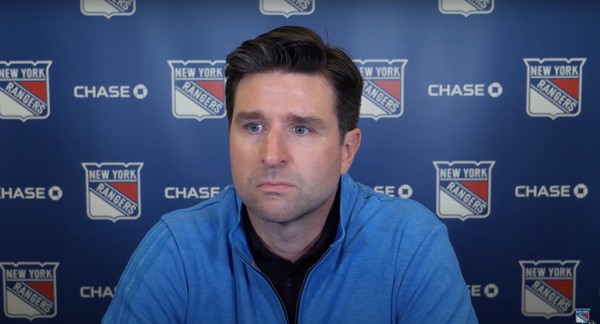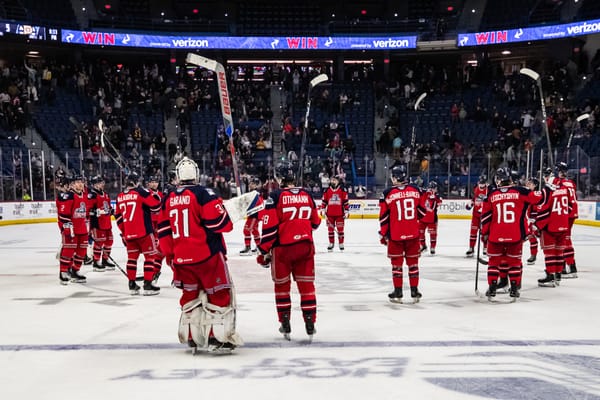Once Upon A Time in RangersTown: Markus Näslund
The first entry in a series looking at Rangers who spent a year or less in New York
With the NHL season on pause, and my main job being a little hectic over the last few weeks, I struggled trying to think about something to write about. But I am glad to announce I have come up with an idea that should help pass the time until hockey returns: “Once Upon A Time in RangersTown.”
In essence, this will be a series looking at players who spent just one season, or less, with the Broadway Blueshirts.
I decided to start with Markus Näslund because he’s one of my favorite NHL players of all time, and to this point I never had a chance to write about him. So with that said, let’s get down to business.
The Player: Markus Näslund | Age 34 | Left Winger
Markus Näslund is one of the NHL’s better players of the mid 1990s to 2000s who doesn’t get considerable attention. At the time he signed with the New York Rangers he had amassed 371 goals and 823 points in 1,035 games.
He was drafted No. 16 overall in the 1991 NHL draft by the Pittsburgh Penguins, and joined the Vancouver Canucks in a lopsided trade that sent Alek Stojanov the other way. Stojanov, who had skated 62 games with the Canucks, would appear in just 45 games with the Penguins and put up a whopping 6 points. As for Näslund, the rest is history, but here are a few interesting things about him.
In 2000-01 he became captain of the Canucks, replacing Mark Messier who left the team in free agency to rejoin the Rangers.
In 2002-03, Näslund finished second in league scoring with 104 points, second in Hart Trophy voting, and captured the Lester B. Pearson, now the Ted Lindsay, award for being the NHL’s most outstanding player as selected by the NHLPA.
The Deal: July 3, 2008 | Two Years, $8 Million ($4M AAV)
Näslund joined the Rangers a few days after free agency opened in July of 2008. The 35-year-old winger was unable to come to terms on a new deal with the Canucks, and took the Rangers offer right away. He had just finished a 2007-08 campaign which saw him post a line of 25-30-55 in 82 games — a continuation of a decline that began after his aforementioned 2002-03 campaign which saw him finish with a line of 48-56-104. The following years saw his production dip to 84, 79, 60 and the aforementioned 55 points. Näslund lost his age 31 season to the 2004-05 NHL lockout, and while he was on the decline, he still had some game left in him.
The Why: Glen Sather was tired of waiting on Jaromir Jagr
The Rangers as a franchise have been lucky enough to have numerous Hall of Fame talents skate for them, but most of the time they’ve had a player join them at a point in which they were past their prime. In July of 2001 the Pittsburgh Penguins moved Jagr to the Washington Capitals, although the Rangers pressed hard to acquire him even believing to be the front runner before the deal was finalized.
His time in Washington wasn’t great, as his production declined from 121 points his final season in Pittsburgh to 79 points in 69 games in year one with the Caps, to 77 points in 75 games in year two. Many know what happened next, but for those who don’t, the Rangers finally completed a long awaited trade in January of 2004 that saw Anson Carter head the other way. It was a salary dump, and the Rangers had more than enough money to take care of Jagr during the pre-salary cap era.
Jagr would only spend 277 regular season games on Broadway, but posted a line of 124-195-319. His defining season came in 2005-06, as Jagr set two new team single season records by scoring 54 goals and tallying 123 points. These numbers are important, as Jagr missed winning the Art Ross by three points (Joe Thornton, 125), and was a runner up for the Hart Trophy (Joe Thornton again).
Had Jagr won either award that season, a major award during his final two seasons with the Rangers, or reached 84 points in his final season on Broadway, his contract would have picked up an additional year which would have covered the 2008-09 season.
But that didn’t happen, and in July of 2008 he was without a contract. Rangers’ general manager Glen Sather grew tired of waiting with negotiations seemingly non-existent.
Jagr was very respectful when I talked to him and gave him the information that we’re going to move on. He told me he wanted to play here, I told him we wanted him to play here, his agent told me he wanted to play here, I told his agent several times, but it never got back to the situation where he said, ‘If you give me X amount of dollars, I’ll come back to play in New York. I kind of always got the feeling that maybe there was something in Russia that is really looking at him, and if there was enough money to stay here he would’ve stayed.
We never got down to that situation where I knew exactly what he was looking for whether it was a one-year or a two-year, or a longer-year term. There was never any discussion like that. It’s pretty tough to negotiate with yourself.
While that was Sather’s side of the story, Jagr’s agent Pat Brisson had a different version of what transpired.
Glen and I had many discussions regarding Jaromir in the past month or so, he said in an e-mail to The Associated Press. It wasn’t a matter of he and or us coming up with the right proposal. Jaromir wants to get a deal done if, when, and or where he sees fit. Time will tell.
Either way, it appears Sather’s suspicion was right as Jagr signed a deal with Avangard Omsk of the KHL just a day after he left the Rangers for $7 million tax free which would be the equivalent of $11 million a year in the NHL at that point in time.
The Season: 43-30-9, 95 points | 4th place in Atlantic Division
The 2008-09 New York Rangers were an interesting group. They opened the season with the 10th best odds (+1500) to win the Stanley Cup which was surprising given the loss of Jagr. Even though Jagr had been in somewhat of a decline, he led the 2007-08 team in scoring, and effectively Näslund was the only major addition to the team.
Things started OK for the Rangers as they went 10-2-1 in the first 13 games of the season. At the All-Star break, the team was second in the division with a record of 28-16-4 and 60 points, and fourth in the conference overall. But then things took a turn for the worst. Out of the break the team lost five games in a row, bounced back with a win vs. the Washington Capitals in the shootout, and proceeded to lose four additional games in a row.
After losing 10 games in a stretch of 12 games, as the Madison Square Garden crowd called for Tom Renney to be fired, enough was enough. On February 23 he was replaced by John Tortorella. Torts was able to get the team back on the rails and the Rangers posted a record of 12-7-2 the rest of the way which enabled them to qualify for the playoffs.
The Rangers then took a 3-1 lead vs. the Washington Capitals in the first round, but proceeded to drop Games 5, 6, and 7 while being outscored by Washington 11 to 4.
The Play: 82 games | 24-22-46 | 17:11 ATOI
Näslund got off to a hot start with the Rangers tallying 11 points in his first month with the team while averaging just 16:31 a game. Renney eased him along, and his second month with the team saw a bump in ice time to 19:08 a game. He finished the month with five goals and four assists.
During the season he played primarily with Scott Gomez as his center and Ryan Callahan as the opposing wing. He also spent nearly 200 minutes 5v5 with Gomez and Nikolai Zherdev, and nearly 100 minutes with Callahan and Drury.
Gomez was in his second — and what would be his final — season as a Ranger, and he finished the season with 58 points in 77 games. Ryan Callahan was in his first full season on Broadway, and the beloved “Black and Blueshirt” finished with a respectable 40 points.
Zherdev was also in his first (and only) season with the team, and he was a very productive player with 23 goals and 58 points while averaging just 16:50 a game which was tied with Gomez for most points by a Ranger in 2008-09.
Drury was in his second season on Broadway, and his season saw him post a line of 22-34-56 in 81 games.
After Näslund’s first two months as a Ranger, he had a respectable 20 points in 27 games (0.74 P/GP), and at the All-Star Break he had 30 points in 48 games (0.63 P/GP).
The rest of the way was tough, as he’d post a line of 9-7-16 over the final 34 games (0.47 P/GP). Goal scoring was a big part of his game during his time on New York, and January and March were two really rough months for the three time 40-goal scorer.
Here’s a look at his production by month
Markus Näslund Scoring Splits
| Month | GP | Goals | Assists | Points | P/GP | ATOI |
|---|---|---|---|---|---|---|
| October | 13 | 4 | 7 | 11 | 0.85 | 16:31 |
| November | 14 | 5 | 4 | 9 | 0.64 | 19:08 |
| December | 12 | 5 | 2 | 7 | 0.58 | 18:48 |
| January | 12 | 1 | 5 | 6 | 0.50 | 17:37 |
| February | 13 | 5 | 1 | 6 | 0.46 | 17:35 |
| March | 13 | 3 | 1 | 4 | 0.31 | 13:57 |
| April | 5 | 1 | 2 | 3 | 0.60 | 15:52 |
It certainly appeared that fatigue and age slowed down Näslund, and his usage under John Tortorella was much different than that under Renney. In the 21 regular season games coached by Tortorella, Näslund averaged 14:55 a game, and posted a line of 6-4-10. This was a significant drop from the 17:57 a night he played previously under Renney. He certainly was efficient under Torts, but overall his entire season was less than optimal overall, although statistically a good return for a $4 million player.
Although the experience was short, the Rangers’ alternate captain didn’t have problems playing for Torts.
He is more intense, both on the bench throughout the games and between periods and stuff, Näslund said of Tortorella. But in a good way. In my experience, and that’s only half a season, I thought he was honest and straightforward. And as a player I appreciate that, even if sometimes it’s stuff you might not like to hear. I appreciate people that bring it to you and are up front.
The End: Näslund Announces Retirement on May 5, 2009
Despite signing a two-year deal with the Blueshirts, after being eliminated by the Washington Capitals in the first round of the playoffs, Näslund ultimately decided it was time to hang up his skates.
His time as a Ranger was short, and if I had to grade it, I’d give it a B-. It wasn’t great, nor was it horrible. I remember sitting at my best friend’s grandparents house in July of 2008 watching TV while we were cooling down after a wiffle ball tournament, and seeing that Jagr was gone and that Näslund was joining the Rangers as a crawler on ESPN. At the time I was gutted that Jagr was leaving, but happy that Näslund was joining the Rangers. He was someone I enjoyed watching, and trading for frequently in the EA NHL games.
There were some really fun moments, including his two-goal game vs. the Tampa Bay Lightning, and his winner in the shootout. There were also numerous games where he just couldn’t score. When teams sign an older player in decline, they are bound to get the good and the bad. Obviously having Jagr stay around could have been nice given what he was able to do later on in his NHL return, but it is possible he just needed a break to reset.
Overall it was an interesting time for the Rangers as they were a team in transition. It started with the departure of Jagr, continued with the in-season departure of Renney, and after Näslund hung things up, the team made some franchise altering moves.
Doing so fortuitously removed his $4 million AAV from the Rangers salary cap, and it is something that was very fortunate for Glen Sather. A month later at the NHL Draft he made the infamous Gomez for McDonagh trade, and subsequently signed Marian Gaborik on the first day of free agency.
In a way, you could say that Näslund joining the team played a role in a chain of events which ultimately led to the Rangers going to the Stanley Cup Final. Had the Rangers come to terms on a two-year deal with Jagr, Näslund doesn’t become a Ranger. Jagr’s money would have remained on the books, and there’s reason to believe the Gomez trade doesn’t get made, nor the subsequent signing of Gaborik.Or the signing of Brad Richards years later and so on.
Obviously this is all speculation, but it is pretty wild to think that in the span of two years, the Rangers went from a 36-year-old Jagr, who posted 71 points, to a 35-year-old Näslund, who posted 44 points, to a 27-year-old Gaborik, who potted 41 goals and tallied 76 points in his first season as a Ranger.
With all that said, I hope you enjoyed the first edition of “Once Upon A Time in RangersTown. I have a couple of players lined up, but welcome suggestions you may have.
Stats via Hockey-Reference unless otherwise noted





